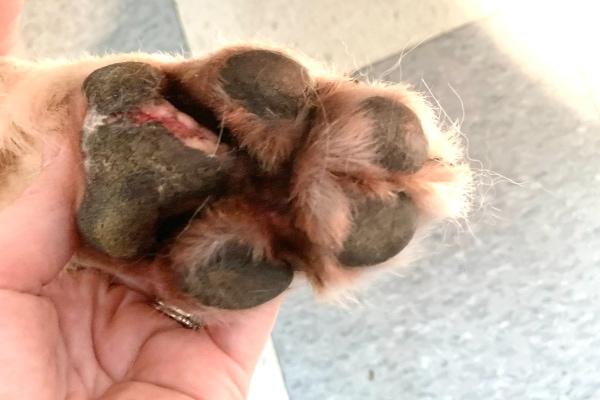Your dog may induce a yeast infection by repeatedly licking his painful paws, which can spread on its own and result in even more itch and suffering.
On canine skin, spore-producing yeasts or fungi typically coexist without posing a threat, but they occasionally have the potential to become out of hand. When this occurs, a dog’s paws get extremely itchy and the dog starts to lick them. They can quickly turn red and inflamed, have a cheesy, musty, or pungent smell, and develop a brown discharge in the nail beds.
Malassezia pachydermatis, a type of yeast that thrives in warm, humid settings, is typically to blame. The most common reason of this overgrowth is allergies, which also cause itching and cause the dog to lick his feet, which leads to moisture buildup and skin damage, which is what causes the yeast overgrowth. Additionally, a cut, abrasion, or other paw injury might cause licking and a Malassezia infection.

The looks and smell of the dog’s paws make it simple to diagnose a yeast infection, but a veterinarian can also make sure of this by looking at some of the dog’s skin cells under a microscope.
Dogs with creases in their skin, too much hair between their toes, underlying medical issues, or immunological illnesses may be vulnerable. Bulldogs, Cocker Spaniels, Basset Hounds, Retrievers, Shih Tzus, Poodles, English Setters, West Highland White Terriers, English Springer Spaniels, and Dachshunds are the breeds most frequently affected by paw pad yeast infections.
Yeast infections are typically secondary, not primary, meaning that they appear after another condition has compromised the dog’s overall health and allowed yeast cells to grow. When a dog develops recurring infections, the veterinarian will seek for indications of an underlying medical issue that may be aggravating the disease. Recurrent Malassezia infections have been linked to a variety of illnesses, including hypothyroidism, Cushing’s disease, food allergies, an autoimmune disorder, and skin cancer.
Chlorhexidine, miconazole, ketoconazole, and itraconazole are medications that treat canine yeast infections; these should be administered as directed by your veterinarian and may involve soaking the affected paws. After treatment, be sure to completely dry your dog’s feet. You may prevent yeast infections from spreading by keeping your dog’s feet dry and clean and visiting your veterinarian as soon as symptoms develop.
Oral antifungal drugs like fluconazole or itraconazole, which inhibit yeast cells from reproducing systemically in severe or recurrent instances.
Ineffective and unsupported by clinical research are common home therapies including vinegar foot soaks, Epsom salt baths, hydrogen peroxide, and witch hazel sprays. Other untested methods include switching to a “yeast-free” or “anti-yeast” dog food or limiting the amount of carbs in your dog’s diet. You can also add yogurt, probiotics, or coconut oil to your dog’s meal.
Making dietary improvements for your dog is a better nutritional strategy. His skin’s health can be enhanced by feeding it higher-quality protein sources and other substances, which will build its defenses against fungus and yeast. A food elimination trial is also necessary if food allergies are suspected; ask your veterinarian for advice on how to carry out a successful food elimination trial.
If you have any questions or would like more information please fill our or contact form for visit our Facebook Page.